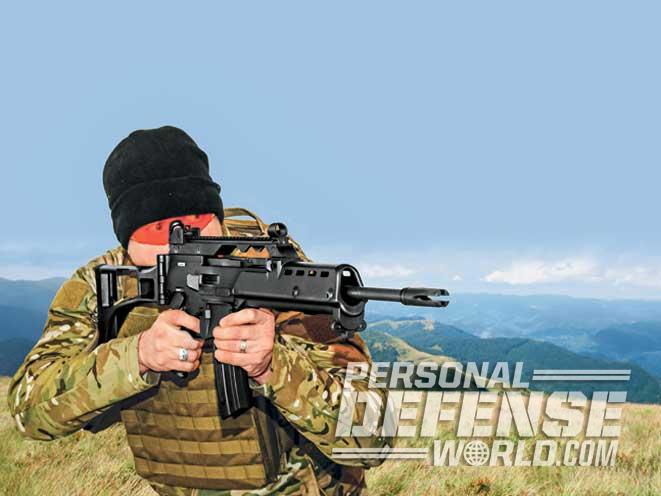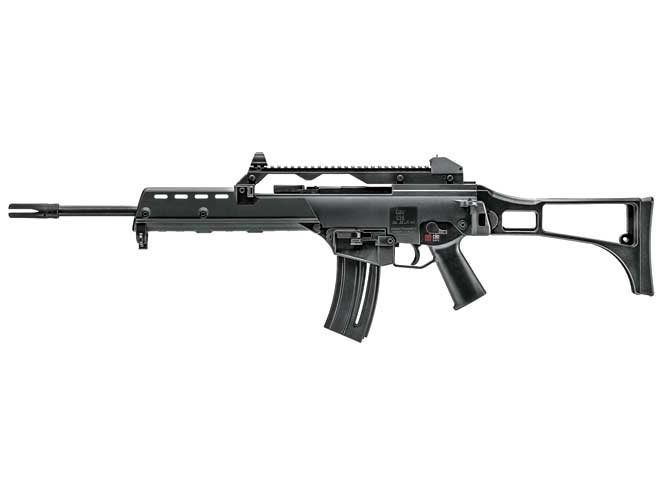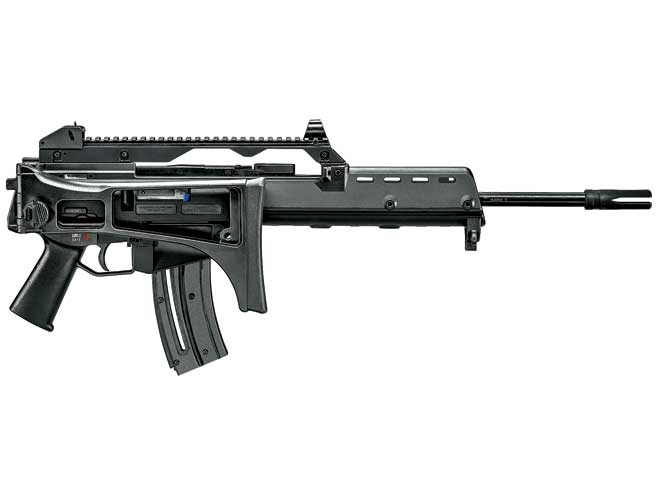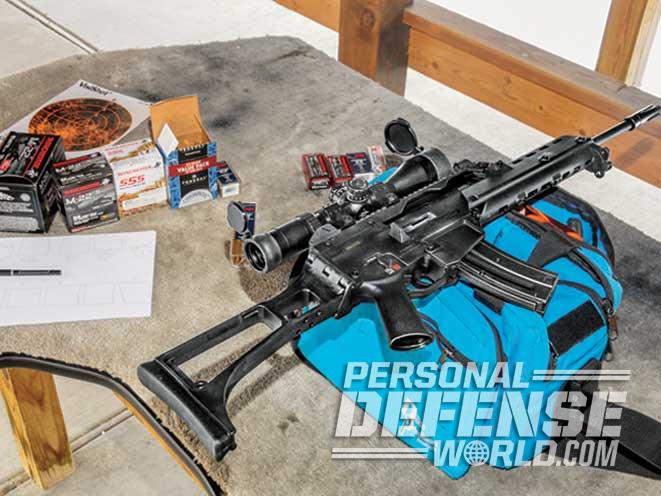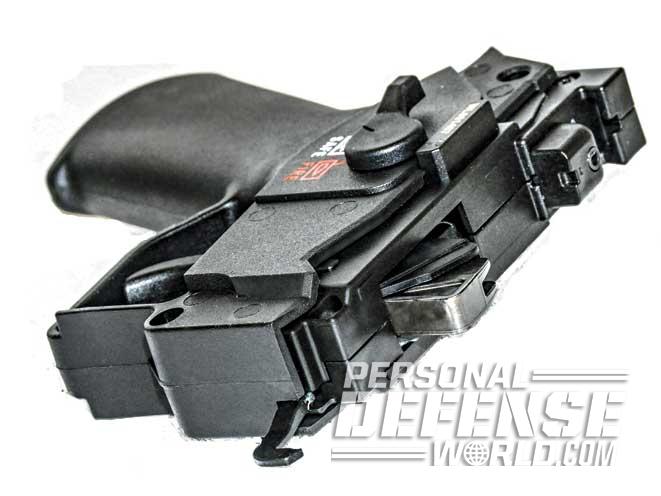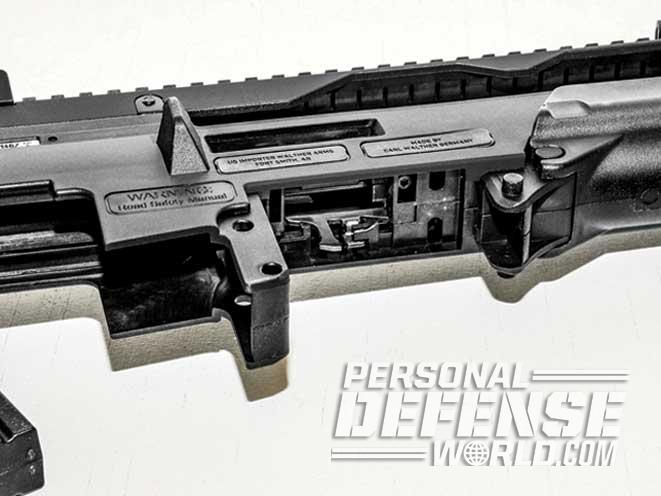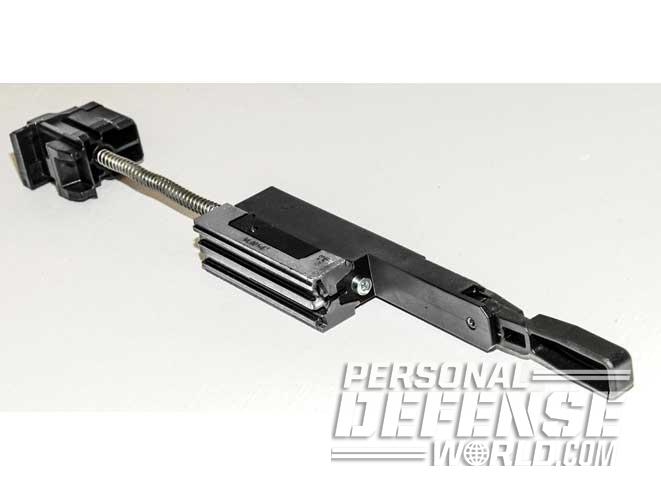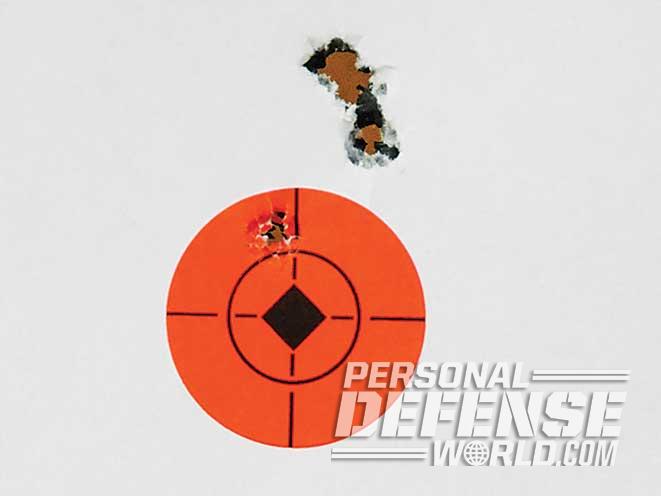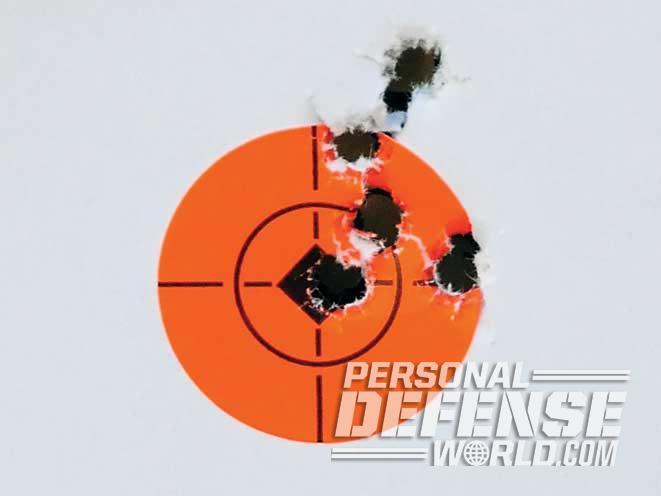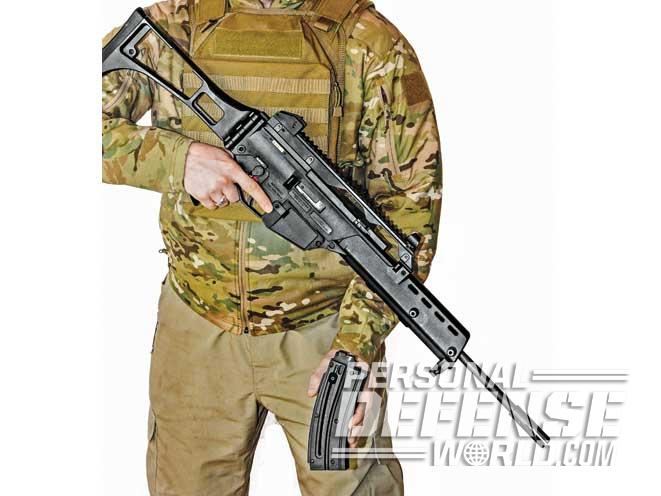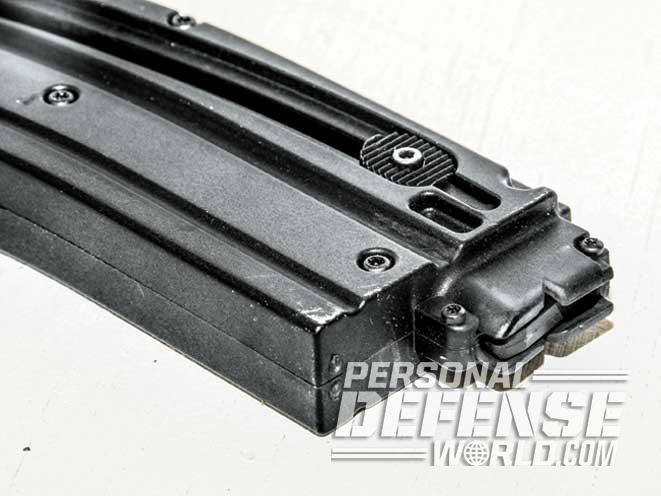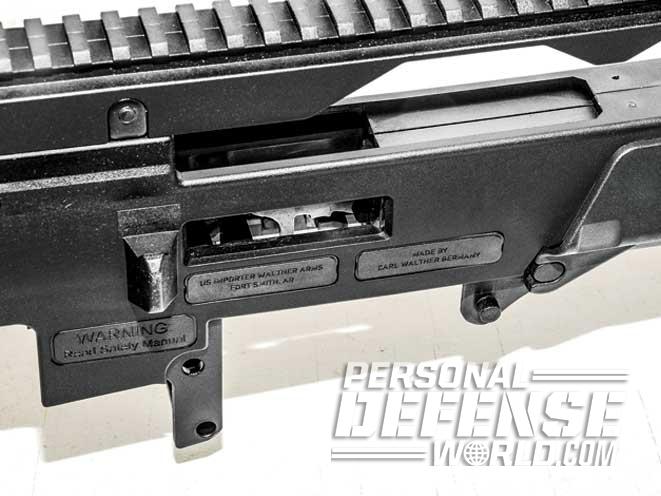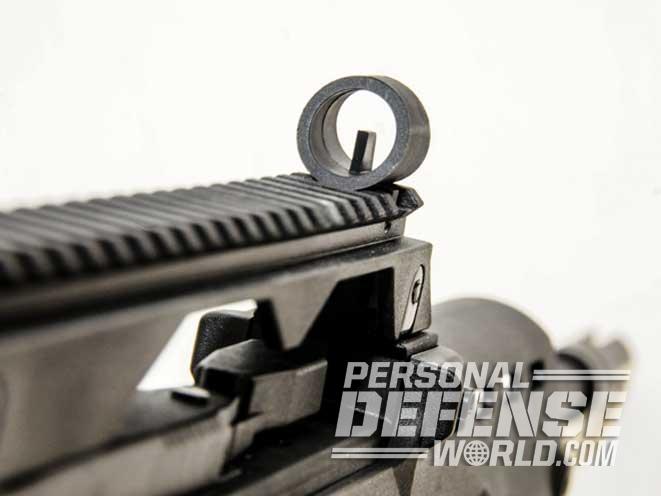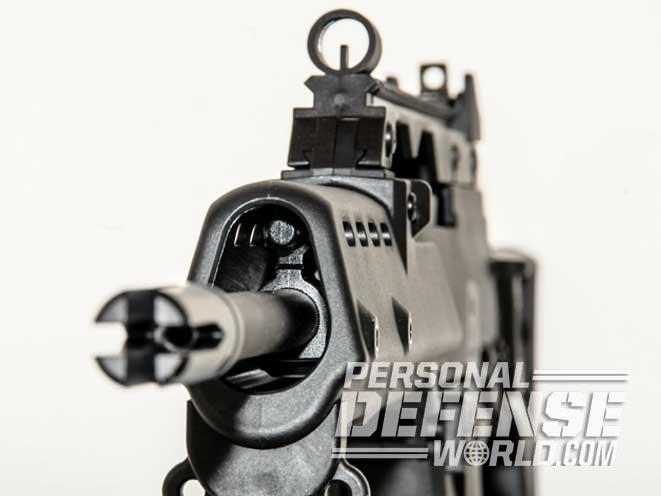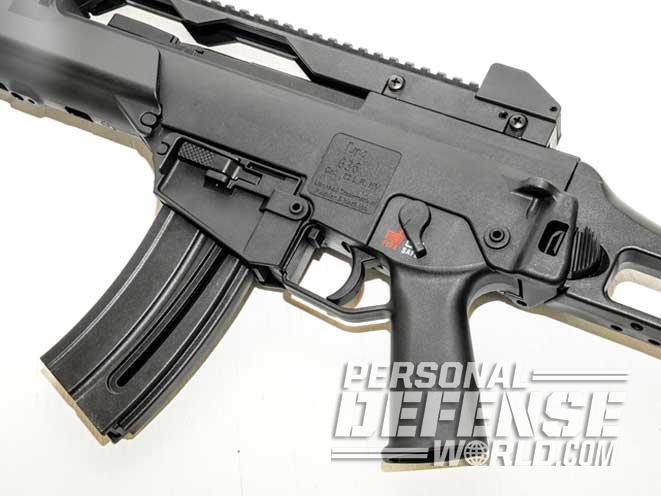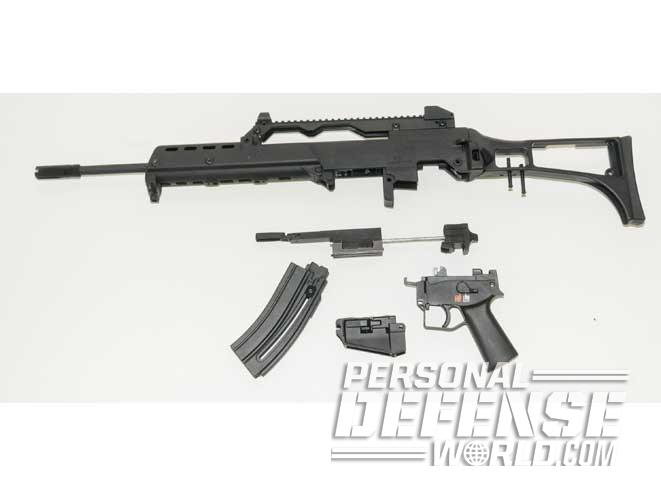I obliterate an orange chunk of clay pigeon, then knock an empty shotgun shell down the berm, seeking and destroying bits of junk at about 35 yards with an Aimpoint sight. There are still a few of the magazine’s 20 rounds left, and I look for more things to obliterate. This is a blast. It’s a great way to spend a Thursday. And it sure looks like I’m shooting a real-deal Heckler & Koch G36. But, of course, I’m not.
The rifle in my hands at the range is a little enigmatic. The box and receiver are both stamped with the famous Heckler & Koch logo, and the model “HK G36.” The box also says “.22 Tactical Rimfire,” and below that, “Made by Carl Walther, Germany.” It is imported by Walther Arms of America, which sells a vast array of rimfire replicas, including officially licensed models from Heckler & Koch and Israeli Weapons Industries (IWI), as well as its own series of centerfire pistols. In other words, you can get a Walther PPK like James Bond or a rimfire replica of an Uzi carbine with a 16.1-inch barrel.
The G36 .22 looks exactly like its identically sized, identically proportioned centerfire counterpart. In hand, it feels a bit more like Walther’s rimfire guns. It’s light. Its construction is primarily polymer, encapsulating the steel components that comprise its dedicated firearm workings. Its sights are polymer, its magazine is polymer and its safety switch is polymer (externally, anyway). But inside, it’s a proper firearm with a steel barrel and bolt, built with a very clever design and beefed up to take plenty of abuse.
Advertisement — Continue Reading Below
So while it looks authentic, it feels like a recreation, and while it is a dedicated recreation (of the 5.56mm G36), this G36 .22 stands completely on its own merits. Before shooting the rifle, I took it apart to understand it better.
Warrior Replica

Any gun mocked up to look like something it’s not is only as good as the firearm inside of it. This is particularly true of guns “dropped into” cosmetic kits, but it also applies to guns built from the ground up like the rimfire replicas in Walther’s HK-licensed line. The G36 is not an existing gun dropped into a body kit at all; rather, it’s a dedicated .22 LR gun with steel parts inside and polymer everywhere else to create the design they’re going for. This is a very good thing, and sets it somewhat apart on the market.
Advertisement — Continue Reading Below
RELATED STORY: Testing Out 3 Rimfire Replicas
The rimfire G36’s action is designed with German ingenuity. To appreciate this, you need to field-strip it; to do that, you need only remove two takedown pins (a simple operation—push them out with your finger) and depress the somewhat hidden takedown button at the rear of the receiver. The first pin frees the magazine well to rotate downward and come off; the second pin allows the grip assembly, containing the trigger group and hammer, to slide down once you depress the takedown button at the rear of the receiver. Pull the bolt (with its integral charging handle, recoil guide rod and recoil spring) out of the back, and you’re all set to poke around with cleaning tools and supplies or just some healthy curiosity.

The bolt has reasonable mass for a blowback-operated rimfire rifle bolt, and it has a long (3 inches) maximum rearward transit distance, which suggests that it can accommodate even the heavier-recoiling (such that they can) .22 LR rounds without the bolt slamming into the rear of the receiver too hard.
Advertisement — Continue Reading Below
Surprisingly, the bolt reciprocates on plastic rails (not metal) that are integrally molded components of the receiver. The chamber is the rearward extremity of the barrel, situated inside a steel block (for extra strength and to secure the unit within the receiver) that is affixed into the polymer housing of the gun with bolts. The barrel measures 18.1 inches long, plus another 2 inches of flash suppressor (which is 2.8 inches long including the part that attaches over the muzzle), and is properly rifled.
The G36 .22 arrived without any lubrication, so before test firing, I added a few strategically deployed drops of Slip 2000. Then I headed to the range on a 37-degree day to see how it ran.
Sighting In
Advertisement — Continue Reading Below

The G36 .22 comes with an elevated sight rail approximately 9.5 inches long between the plastic front sight housing and the plastic rear sight assembly. These assemblies are removable via two roll pins. The rear sight is adjustable for windage and elevation, and it arrived set to hit approximately 11 inches low at 50 yards (as I found out in testing).
RELATED STORY: 8 .22 LR Rimfire Conversion Kits
The rail the sights are attached to is easily removed and replaced with other rails, likely including authentic G36 rails with integral optics. This allows you to swap out true flattop rails if you like or get fancy with other options. Once the old-school purist in me settled down, the plastic sights proved perfectly fine and acceptable for plinking and fun, tactical-style shooting. That they recreated the sight picture of the battle-issue G36 was a nice bonus, and when the bullets started firing, it didn’t matter anymore what they were made of—they worked fine.
Advertisement — Continue Reading Below
The rear sight itself is an indexable steel tab marked, rather optimistically, “300” on one tab and “100/200” on the other. In off-hand “tactical” shooting at 40 yards, I found no discernible difference in the point of impact between them.
The front and rear sights made mounting a magnified optic difficult, but this rifle—meant to shoot fast for fun and plinking inside 100 yards—isn’t really the ideal candidate for the size and power of glass I put on it. Nonetheless, I situated a Weaver Kaspa scope, with its enormous 50mm objective, so the rear objective went over the rear sight, with the sight tab itself pressing against the magnification ring. Risers would have helped, but I didn’t have any handy at the time.
Performance
Advertisement — Continue Reading Below

I’m grateful to Winchester, Federal and CCI for providing an extraordinary variety of ammunition with which to test both the durability and accuracy of the G36 .22. From the first round to the last—several bricks and many boxes of rounds later—the G36 did not suffer any gun-related malfunctions, and only a few failures to ignite (which I confirmed were not gun-related by second-striking their primers and checking that they were sufficient to ignite a functional round).
The rifle felt noticeably more snappy—in a good way—with the heavy-hitting 40-grain CCI Velocitor plated hollow-point rounds, which brand literature states achieves a velocity of 1,435 fps. The fastest ammunition I tested was Winchester’s Varmint LF, which pushed a tin projectile along at 1,650 fps, followed closely behind by CCI’s Segmented 32-grain hollow point at 1,640 fps. These didn’t have the same sort of perceived snap as the Velocitor ammo but certainly got downrange in a hurry.
The only failure to feed was user-induced. The 20-round magazine has a neat way of alternating, left-right-left, the cartridge bodies in the stack (partly a function of their rims getting in the way of a more orderly single-file line), as the curve to their feed-path is not quite steep enough to allow the natural arc of 20 rimfire cartridges atop each other. As with any such capacity rimfire magazine, it behooves the shooter to use the finger pads on the follower assembly to run the cartridges up and down slightly to nestle them in alignment, and get the topmost round nose-up enough to feed (rather than nose-down). I didn’t do that on one magazine to see what would happen. The bolt smashed the round forward, failing to chamber it—because I caused it to do that.
Advertisement — Continue Reading Below

As a recoil-operated rimfire, the action got dirty with unburned grains of powder and associated fouling. I inspected it after more than 750 rounds fired, not because it stopped working—it just kept on going—but because I was curious. Then I reassembled it and kept shooting without issue. Rate of fire was not an issue for reliability, nor was the amount of surface area rubbing together as the charging handle assembly reciprocated on every shot right along with the long, heavy bolt. Over time and through inclement weather, dirt and sand getting into its channel may slow it down enough to become an issue.
RELATED STORY: Top 10 Rimfire Guns for CCW Self Defense
The accuracy presented another duality with this rifle, both vexing and excitingly adequate. The best performance was with CCI’s Mini-Mag ammunition, which had a day-winning 0.66-inch, five-shot group at 50 yards—right after printing a comparatively dismal 1.72-inch group. Nothing was changed, including my position on the rest, between shots or between strings. The optimist in me says the rifle is clearly up to a task that my skill only reaches occasionally, while the pessimist in me is confused by those groups and similar pairs throughout the test. I can safely assume that the error is human.
Advertisement — Continue Reading Below
Certainly the G36 .22 is capable of minute-of-soda-can accuracy at 50 yards with a scope, and probably with iron sights if you’re really, really talented. If not, that’s what the other 19 rounds in the 20-round magazine are for.
At 25 yards, especially with the Winchester 555 ammo (returning a 0.41-inch, five-shot group) and the Mini-Mag rounds (with a 0.47-inch group), the G36 .22 holds minute-of-squirrel groups with a scope and will almost certainly outperform the shooter with iron sights.
High-Speed Plinking

Next, I slapped an Aimpoint Micro onto the rimfire G36 and hit the gravel pit for some run-and-gun fun, where I really felt the heat and excitement. Now that’s where this rifle excels—as a tremendous companion for high-speed steel plate plinking, can shredding, target star bouncing, golf ball annihilating and helping enormously with that problem of having too much rimfire ammunition on hand…. You can tell it was really fun and performed admirably at the range.
Once I started using the Aimpoint sight, I was able to hit 1-inch round plastic targets off-hand at 25 yards with a fair amount of regularity. When I switched to steel spinners and plates, the fun increased, but I discovered the drawback of the stock trigger, which has a long pull and is rather the opposite of crisp. It will do for informal plate matches and fun shooting, for plinking and for training new shooters on proper firearm safety—an area where a nice, long trigger pull can sometimes be a good thing.
While the body pins are easily removed without tools, making takedown a breeze, the one located just in front of the triggerguard is a bit vexing—it is located right where an AR’s magazine release is located, it sticks out about as far as an AR’s mag release button, and it depresses like a mag release button. But unlike a magazine release button, it doesn’t release a magazine, or really, do anything unless you pull it out of the left side. I never did quite get over the muscle memory of pushing on that pin to release the magazine (the magazine release is on the left side of the action, more or less where the bolt release is on an AR), and solved my problem in part by removing the pin and inserting it from the right side. Then at least it wouldn’t go anywhere as I pushed on it, reminding me that I had to push something else to get the magazine out.
The rimfire G36’s actual magazine release is easy to access and manipulate with your left hand, presenting no mechanical issues at all, and it’s even protected by a small plastic ridge to prevent accidental ejection of the magazine, which is very well and good but still confusing to the muscle memory of someone intimately familiar with modern sporting rifles. That can be easily fixed, however, with enough practice.
Fun Firepower

The G36 .22 is a lot of fun. Keep it inside 100 yards and you should be able to make cans dance all day long. Hit gallon jugs at 100 yards if you like. Take it afield (10-round magazines are available for restricted areas and hunting) if you want to get tactical with your small-game hunting and impress your friends and everyone else at the range. The looks are amazing, and amazingly authentic. The performance is reliable, suitably accurate and so much fun that you can easily lose yourself in an Heckler & Koch daydream all afternoon.
RELATED STORY: 4-Point Training for Rock Solid Plinking
For more information, visit http://www.waltherarms.com or call 479-242-8500.
